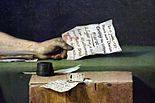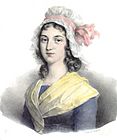Charlotte Corday facts for kids
Quick facts for kids
Charlotte Corday
|
|
|---|---|
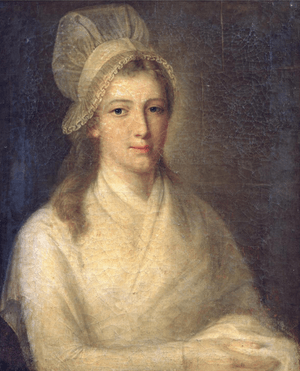
Charlotte Corday, painted at her request by Jean-Jacques Hauer, a few hours before her execution
|
|
| Born |
Marie-Anne Charlotte de Corday d'Armont
27 July 1768 |
| Died | 17 July 1793 (aged 24) |
| Cause of death | Execution by guillotine |
| Known for | Assassination of Jean-Paul Marat |
| Parent(s) |
|
| Signature | |
 |
|
Marie-Anne Charlotte de Corday d'Armont (27 July 1768 – 17 July 1793), known as Charlotte Corday (French: [kɔʁdɛ]), was a figure of the French Revolution. In 1793, she was executed by guillotine for the assassination of Jacobin leader Jean-Paul Marat, who was in part responsible for the more radical course the Revolution had taken through his role as a politician and journalist. Marat had played a substantial role in the political purge of the Girondins, with whom Corday sympathized. In 1847, writer Alphonse de Lamartine gave Corday the posthumous nickname l'ange de l'assassinat (the Angel of Assassination).
Contents
Biography
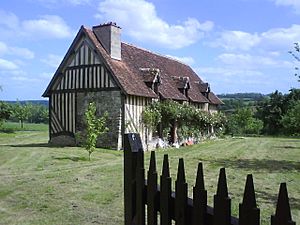
Born in Saint-Saturnin-des-Ligneries, a hamlet in the commune of Écorches (Orne), in Normandy, Charlotte Corday was a member of a minor aristocratic family. She was a fifth-generation descendant of the dramatist Pierre Corneille. Her parents were cousins.
While Corday was a young girl, her older sister and their mother, Charlotte Marie Jacqueline Gaultier de Mesnival, died. Her father, Jacques François de Corday, Seigneur d'Armont (1737–1798), unable to cope with his grief over their deaths, sent Corday and her younger sister to the Abbaye aux Dames convent in Caen, where the former had access to the abbey's library and first encountered the writings of Plutarch, Rousseau and Voltaire. After 1791, she lived in Caen with her cousin, Madame Le Coustellier de Bretteville-Gouville. The two developed a close relationship, and Corday was the sole heir to her cousin's estate.
Corday's physical appearance is described on her passport as "five feet and one inch ... hair and eyebrows auburn, eyes gray, forehead high, mouth medium size, chin dimpled, and an oval face".
Political influence
After the revolution radicalized further and headed towards terror, Charlotte Corday began to sympathize with the Girondins. She admired their speeches and grew fond of many of the Girondist groups whom she met while living in Caen. She respected the political principles of the Girondins and came to align herself with their thinking. She regarded them as a movement that would ultimately save France. The Girondins represented a more moderate approach to the revolution and they, like Corday, were skeptical about the direction the revolution was taking. They opposed the Montagnards, who advocated a more radical approach to the revolution, which included the extreme idea that the only way the revolution would survive invasion and civil war was through terrorizing and executing those opposed to it. The opposition to this radical thinking, coupled with the influence of the Girondins, ultimately led Corday to carry out her plan to murder one of the most outspoken and popular Montagnard radicals, Jean-Paul Marat.
Corday's action aided in restructuring the private versus public role of the woman in society at the time. The idea of women as second class or less than was challenged, and Corday was considered a hero to those who were against the teachings of Marat. There have been suggestions that her act incited the banning of women's political clubs, and the executions of female activists such as the Girondin Madame Roland.
The influence of Girondin ideas on Corday is evident in her words at her trial: "I have killed one man to save a hundred thousand." As the revolution progressed, the Girondins had become progressively more opposed to the radical, violent propositions of the Montagnards such as Marat and Robespierre. Corday's notion that she was saving a hundred thousand lives echoes this Girondin sentiment as they attempted to slow the revolution and reverse the violence that had escalated since the September Massacres of 1792.
Marat's assassination
Jean-Paul Marat was a member of the radical Jacobin faction that had a leading role during the Reign of Terror. As a journalist, he exerted power and influence through his newspaper, L'Ami du peuple ("The Friend of the People"). Corday's decision to kill Marat was stimulated not only by her revulsion at the September Massacres, for which she held Marat responsible, but by her fear of an all-out civil war. She believed that Marat was threatening the Republic, and that his death would end violence throughout the country. She also believed that King Louis XVI should not have been executed.
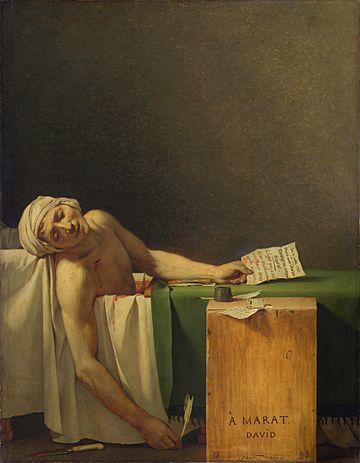
On 9 July 1793, Corday left her cousin, carrying a copy of Plutarch's Parallel Lives, and went to Paris, where she took a room at the Hôtel de Providence. She bought a kitchen knife with a 6-inch (15 cm) blade. During the next few days, she wrote her Adresse aux Français amis des lois et de la paix ("Address to the French, friends of Law and Peace") to explain her motives for assassinating Marat.
Corday initially planned to assassinate Marat in front of the entire National Convention. She intended to make an example of him, but upon arriving in Paris she discovered that Marat no longer attended meetings because his health was deteriorating due to a skin disorder (perhaps dermatitis herpetiformis). She was then forced to change her plan. She went to Marat's home before noon on 13 July, claiming to have knowledge of a planned Girondist uprising in Caen; she was turned away by Catherine Evrard, the sister of Marat's fiancée Simonne.
On her return that evening, Marat admitted her. At the time, he conducted most of his affairs from a bathtub because of his skin condition. Marat wrote down the names of the Girondins that she gave to him; she then pulled out the knife and plunged it into his chest. He called out: Aidez-moi, ma chère amie! ("Help me, my dear friend!"), and then died.
This is the moment memorialized by Jacques-Louis David's painting The Death of Marat. A different angle of the iconic pose of Marat dead in his bath is in Paul-Jacques-Aimé Baudry's 1860 painting Charlotte Corday.
In response to Marat's dying shout, Simonne Evrard rushed into the room. She was joined by a distributor of Marat's newspaper, who seized Corday. Two neighbours, a military surgeon and a dentist, attempted to revive Marat. Republican officials arrived to interrogate Corday, and to calm a hysterical crowd who appeared ready to lynch her.
Trial
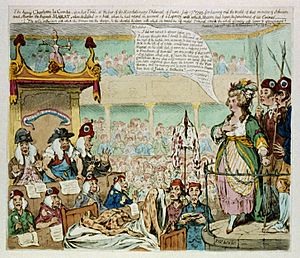
Charlotte Corday sent the following farewell letter to her father which was intercepted and read during the trial, the letter helping to establish that Marat's murder was premeditated:
Forgive me, my dear papa, for having disposed of my existence without your permission. I have avenged many innocent victims, I have prevented many other disasters. The people, one day disillusioned, will rejoice in being delivered from a tyrant. If I tried to persuade you that I was passing through England, it was because I hoped to keep it incognito, but I recognized the impossibility. I hope you will not be tormented. In any case, I believe that you would have defenders in Caen. I took Gustave Doulcet as a defender: such an attack allows no defense, it's for the form. Goodbye, my dear papa, please forget me, or rather rejoice in my fate, the cause is good. I kiss my sister whom I love with all my heart, as well as all my parents. Do not forget this verse by Corneille: Crime is shame, not the scaffold! It is tomorrow at eight o'clock that I am judged. This 16 July.
Corday underwent three separate cross-examinations by senior revolutionary judicial officials, including the President of the Revolutionary Tribunal and the chief prosecutor. She stressed that she was a republican and had been so even before the Revolution, citing the values of ancient Rome as an ideal model.
The focus of the questioning was to establish whether she had been part of a wider Girondist conspiracy. Corday remained constant in insisting that "I alone conceived the plan and executed it." She referred to Marat as a "hoarder" and a "monster" who was respected only in Paris. She credited her fatal knifing of Marat with one blow not to practicing in advance but to luck.
Charlotte Corday asked for Gustave le Doulcet, an old acquaintance, to defend her, but he did not receive the letter she wrote to him in time, so Claude François Chauveau-Lagarde was appointed instead to assist her during the trial. It is believed that Antoine Quentin Fouquier-Tinville voluntarily delayed the letter, however, it is said that Corday thought that Le Doulcet refused to defend her and sent to him a last letter of reproach just before going to the scaffold.
Execution
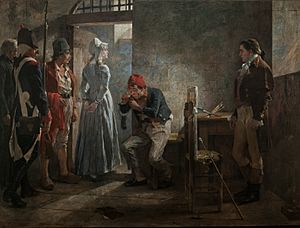
Following her sentencing Corday asked the court if her portrait could be painted, purportedly to record her true self. She made her request pleading, "Since I still have a few moments to live, might I hope, citizens, that you will allow me to have myself painted." Given permission, she selected as the artist a National Guard officer, Jean-Jacques Hauer, who had already begun sketching her from the gallery of the courtroom. Hauer's likeness (see above) was completed shortly before Corday was summoned to the tumbril, after she had viewed it and suggested a few changes.
Since her execution, many authors have written describing Corday as a natural blonde, primarily due to this portrait by Hauer. Although Hauer admired her and took a keen interest in her fate he had to depict Corday as a vain aristocrat and counterrevolutionary for his own protection. To give the idea that she had taken the time to make herself presentable and powder her hair before murdering Marat, Hauer painted Corday's hair a very light shade. Despite the fame of this one portrait, many other paintings (done both in life and posthumously) show Corday in her true brunette form, and her passport describes her hair as "chestnut" (châtains), refuting the idea that Corday had fair hair.
On 17 July 1793, four days after Marat was killed, Corday was executed in the Place de Grève.
The Revolution and women
Corday's killing of Marat was considered vile, an "arch-typically masculine statement", which reaction showed that whether or not one approved of what she did, it is clear that the murder of Marat changed the political role and position of women during the French Revolution. Corday was surprised by the reaction of revolutionary women, stating, "As I was truly calm I suffered from the shouts of a few women. But to save your country means not noticing what it costs."
After Corday murdered Marat, the majority of women distanced themselves from her because they believed that what she had done would spark a reaction against the now developing feminist movement, which was already facing criticism. Also, many of these women were attached to Marat in that they were supporters of his revolutionary efforts and sympathized with him as citizens of France.
Gallery
-
Detail from The Death of Marat by Jacques-Louis David. Marat's dead hand grips a piece of bloody paper which reads, "July 13, 1793. Marie Anne Charlotte Corday to Citizen Marat. Suffice it to say that I am very unhappy to be entitled to your benevolence."
See also
 In Spanish: Charlotte Corday para niños
In Spanish: Charlotte Corday para niños






